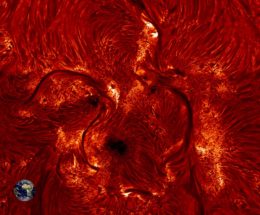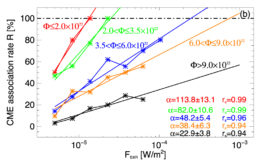Solar activity sometimes stays trapped close to the Sun’s surface — but sometimes it breaks free in enormous ejections of hot plasma. What determines whether a solar flare stays confined or is followed by a catastrophic eruption? A new study reveals clues.
A Flare Conundrum

False-color H-alpha image of an active region on the Sun’s surface. The Earth is provided in the corner for scale. Click to enlarge. [Dutch Open Telescope]
At the height of the solar cycle, when active regions are more common, the Sun expels around three CMEs per day — and the most violent of these can disrupt radio transmissions on Earth, damage satellites in orbit, and even produce power outages. To predict these catastrophic eruptions, it’s critically important that we better understand the origin of CMEs and how they are launched from active regions.
So what determines whether a solar flare stays confined to the Sun’s surface, or whether it’s associated with an eruptive CME? A new study led by Ting Li (National Astronomical Observatories, Chinese Academy of Sciences) now further explores how the fate of a flare may be influenced by the active region where it originates.
Digging Into the Data
Li and collaborators analyzed observations of more than 700 solar flares cataloged by the Geostationary Operational Environmental Satellite (GOES) system between 2010 and 2019. The authors compared these data to CME catalogs from satellites like the Solar and Heliospheric Observatory (SOHO) to determine which flares were associated with eruptions and which ones stayed confined.
The team then explored the properties of the active regions that produced these flares. For each flare, Li and collaborators used corresponding vector magnetograms — images that trace the 3D magnetic field on the solar disk — from the Helioseismic and Magnetic Imager (HMI) to calculate the total magnetic flux passing through the active regions just before flare onset.
To Trap an Eruption

The relation between the flare–CME association rate (i.e., what percentage of flares are accompanied by CMEs) and flare intensity is plotted here for five different bins of active region total magnetic flux (different colors). For each bin, CMEs are more common for larger flares. But the slope of the relation is steeper for smaller active region flux, which means a flare of a given intensity is more likely to be confined if the active region flux is larger. Click to enlarge. [Adapted from Li et al. 2021]
But they also determined that the total magnetic flux of the active region plays an important role in determining the eruptive character of solar flares. As the flux of the active region increases, the slope of the relationship between flare intensity and the flare–CME association rate becomes less steep.
What does this mean? For a given flare intensity, the flare is more likely to come with an eruptive CME if its active region has less magnetic flux. More magnetic flux means that there’s stronger confinement of the flare by an overlying background field, preventing it from erupting.
These results provide a valuable framework for understanding the flare–CME connection, not just on the Sun, but also on other solar-type stars in the galaxy — thus bringing us a step closer to being able to predict the potential impacts of flaring activity in our solar system and other planetary systems like it.
Citation
“Magnetic Flux and Magnetic Nonpotentiality of Active Regions in Eruptive and Confined Solar Flares,” Ting Li et al 2021 ApJL 917 L29. doi:10.3847/2041-8213/ac1a15

